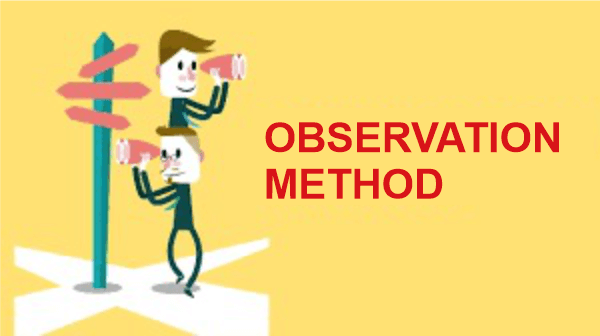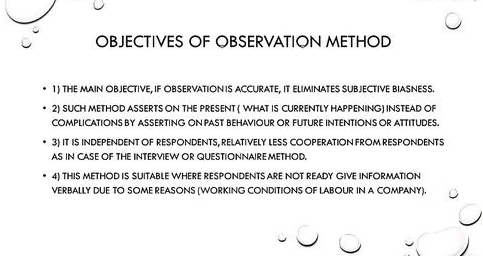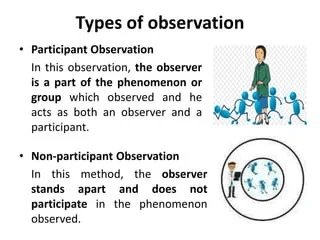Advantages and Disadvantages of Observation MethodThe most popular technique for gathering data about numerous objects around us is to observe and research the environment. Things varied processes should also be observed and monitored. Therefore, observation is the primary approach for gathering information about anything. Researchers sometimes use observation for their various study projects in a scientific manner, although it is important to remember that not all observations are scientific. 
What is the observation method?We always notice and observe the events around us in our daily lives. Such an observation frequently results in a choice. For instance, while we go down the street, we see vehicles and people moving in various directions. Based on these findings, we could decide whether to cross the street. We can act following such a determination. We also keep an eye out when driving to observe if the light is green or not, as well as the street conditions, other moving vehicles, people on foot or in bicycles, etc., and we drive accordingly to prevent accidents from happening when someone suddenly leaps in front of a moving vehicle. The active collection of information from a primary source is referred to as observation. Observation in living beings makes use of the senses. Observation in science can also refer to the interpretation and recording of data using scientific instruments. The term could also be applied to any data gathered during the course of the scientific activity. Observations can be qualitative, which means that only the lack or presence of a property is noted, or quantitative, which means that a numerical value is assigned to the observed phenomenon by counting or measuring it. Qualitative observation is the method used to gather data by watching the subjects in a natural setting, then the data is analysed. The basis for observation is a subject's attitude and beliefs, behavioural patterns, psychological makeup, and other factors. The observation approach entails paying attention to, feeling, documenting, and observing the actions, attitudes, and traits of things, phenomena, or living things. The researchers employ this technique to comprehend the subject's behaviour and personality. On the other hand, scientific observation must be systematic, deliberate, and definite to provide a description, establish relationships between events, identify the reasons for those relationships, and test hypotheses. A researcher can utilize the observational approach to document the behaviour of young students. If the kids feel safe sharing their lunchboxes at such an early age, the study will be worthwhile for the researcher. In this case, the researcher can observe and record the information impartially. Since it requires a research participant's full consent, the observation data-gathering approach is linked to a few ethical concerns. 
Types of Observation Methods
Usually conducted in a psychology lab, controlled observations are systematic observations. Many variables are under the researcher's control, including participants, the site of the observation, the timing of the study, the context in which it was conducted, and more. The researcher will frequently develop codes to represent various behaviours throughout this investigation. They can then classify behaviour into several categories and more easily examine the data rather than create a comprehensive report.
Another form of observation research technique employed by market researchers is naturalistic observation. Market researchers examine participants' actions in a natural setting when doing this kind of observation. Typically, there are no established behavioural codes. The researcher will instead take meticulous notes and code the information later. In several scientific disciplines, including anthropology, linguistics, the social sciences, and psychology, naturalistic observation-also known as fieldwork-is a study methodology that collects data without the observer's intervention as they happen in nature.
Participant observation is the final kind of observation technique. Because participants will be observed in their natural environment, this is a naturalistic observation. The distinction is that market researchers will ingratiate themselves with the surroundings. One form of the data-gathering technique employed by practitioner-scholars in qualitative research and ethnography is participant observation. A certain group of people and their traditions are to be closely and intimately familiarised with through intense interaction with people in their cultural context, typically over an extended period. 
Advantages of the Observation MethodTo collect data, observation is used in international market research. It has evolved into the most sophisticated modern research methodology. The benefits of the observation approach include the following:
The most popular and straightforward way to get data is undoubtedly through observation. It only calls for a little technical expertise. Even though it necessitates some technological expertise on the researcher's part, scientific controlled observation is still simpler than other approaches. In their daily lives, everyone on this planet witnesses a wide variety of things. A person can become perfect at observing his environment with a little practice.
One of the key sources for developing hypotheses is observation. The researcher can become remarkably familiar with the phenomenon they are regularly observing. He learned about their customs, preferences, issues, perceptions, various pursuits, and more. All these aids him in developing a hypothesis about them. Therefore, being a good observer is essential for any researcher.
The data obtained through observation is frequently more accurate than that obtained through interviews or questionnaires. The researcher must rely on the information provided by the respondents when using alternative methods, such as an interview or questionnaire. These are, therefore, indirect approaches, and the investigator needs help to check the integrity of the information they have provided. However, during observation, the observer can immediately verify the observer's correctness. He can use various tools to check their behaviour's consistency.
Whether it be scientific or social sciences, observation is commonly employed in all of them. As a result, its application is more widespread. It is quite simple to follow and accept as a regular practice.
The only option when dealing with animals is observation. Observation can deal with phenomena such as infants or animals who cannot verbally express their feelings or activities, let alone give verbal information about their behaviour. When researching infants, observation is essential because they cannot communicate or comprehend the researcher's questions. Observation will be the sole useful technique for those who are unable to hear, have severe abnormalities or are insane, are uncooperative, are too bashful, or do not speak the researcher's language.
Observation is independent of people being willing to provide various information about themselves. Many times, some individuals feel uncomfortable talking about themselves with an outsider. Some people need more time or expertise to give the researcher crucial information. Even though observation cannot always solve these issues, it nevertheless calls for less active cooperation and response willingness. It is always possible to observe someone without them being aware of it.
The fundamental benefit of observation is that it is straightforward. The observer does not need to question subjects about their actions and reports from others. Data can be gathered as it happens. They only need to observe how people behave and speak. The observer observes events as they occur, whereas the survey respondents may have vague or lapsed memories about things that happened in the distant past.
Every piece of information must start as an experience or impression. Direct observation must always be attempted because it is the most reliable method. It can be used as a scientific tool using current mechanical and electronic technology, from the most informal to the most formal. It fulfils the demands of a specific circumstance. Data gathered through observation will be the most trustworthy of all data gathered.
Observation is the only relevant method for uncooperative individuals who are hesitant to share information regarding their behaviour. Information that customers are not able or unwilling to disclose can be learned through observation. For research on young children unable to comprehend our questions or express themselves clearly, observation is essential. Disadvantages of the Observation MethodThere are some restrictions on observation. An observation typically costs too much money and takes too much time. It is simple to execute precisely planned laboratory experiments.
The observer's understanding of customer behaviour must be clear. They should be free from bias and have a reliable frame of reference. The observer's incompetence could compromise the validity and reliability of the observation.
These issues develop because of the event's uncertainty. Numerous social events have a very ambiguous nature. Finding their time and location is a challenging assignment for the researcher. The incident might occur without the observer present. On the other hand, it might not happen even if the observer is always present. For instance, it is never certain if two people or groups will argue or fight. The exact date of the event is still being determined.
Most social phenomena are conceptual. For instance, parents' feelings of love, affection, and emotion for their children are not visible to our senses and cannot be measured using observational methods. To explore these phenomena, the researcher may use additional techniques like case studies, interviews, etc.
The observer often prefers to focus on what he wants to see. People may have different perspectives on what is happening even when exposed to identical conditions. The specifics that different witnesses who witnessed the same incident report are influenced by their strong personal interests, emotions, motivations, etc. To construct his observation, an observer must rely on his recollection. In such circumstances, he ought to note his observation right away. Therefore, improper documentation negates the fundamental objective of observation.
Being observed interferes with oneself. The act of observation itself carries the risk of distorting the phenomenon. It introduces a bias unknowable in terms of its direction and magnitude. It is challenging to get rid of this distortion. But it can be lessened by correct selection and placement of observers an appropriate choice of observers and their location, covert recording, and other efforts to prove observer neutrality.
According to P.V. Young, no attempt is made to employ precise instruments during observation to verify the accuracy of the phenomenon. Generalizations drawn using the observation approach are not very trustworthy because social phenomena cannot be controlled or subjected to laboratory experiments. Again, drawing meaningful conclusions from observation is challenging due to the relative nature of social phenomena and the observer's own bias.
Observation requires an elevated level of technical skill. One can never be certain that what they are seeing is what they think they are seeing. The same phenomenon could be viewed differently by two people. A scenario could offer something significant and helpful to one individual while offering nothing to another. Only observers who possess the necessary technical expertise can make scientific observations.
The spectator may have their moral standards or distinct preconceptions about an incident, which renders sociological research objective.
P.V. Young is correct when he says that valid observations cannot be hastened, and that observation alone cannot allow us to complete our inquiry quickly. It can occasionally make the observer, and the observed less interested in continuing their observation procedure.
It costs a lot, takes a lot of time, and demands a lot of work. Traveling, lodging at the location of the phenomenon, and purchasing expensive equipment are all necessary for observation. It is regarded as one of the most expensive ways of data collection as a result.
The complete answers "cannot be gathered by observation alone," according to P.V. Young. As a result, several people recommended that observation needs to be supported by additional techniques.
Verifying an observation's validity can be challenging. Many observational phenomena are difficult to define precisely enough to allow for the creation of useful generalizations. The validity and reliability of the observation may need to be improved by the observer's incompetence. Comparison Table for the advantages and disadvantages of the Observation Method
|
 For Videos Join Our Youtube Channel: Join Now
For Videos Join Our Youtube Channel: Join Now
Feedback
- Send your Feedback to [email protected]
Help Others, Please Share










